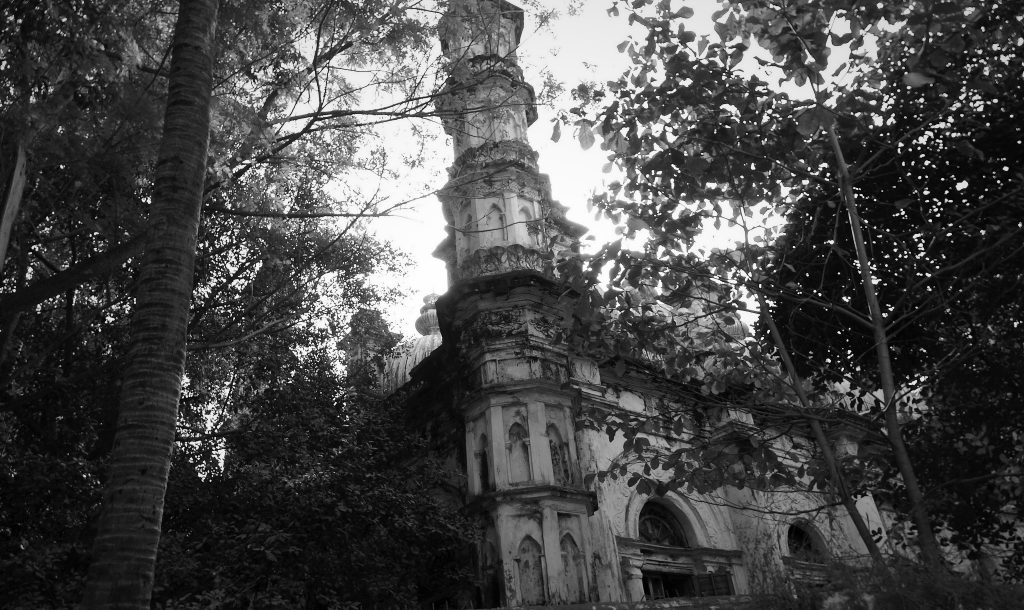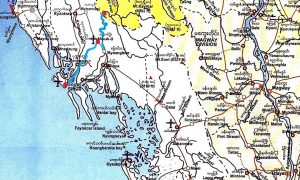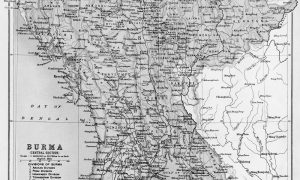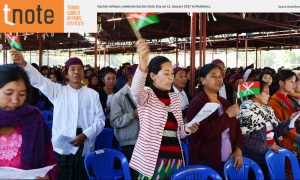In the last few weeks, over 400,000 Rohingya Muslims have fled a bloody pogrom in Myanmar’s Rakhine state, crossing into Bangladesh. Among the horrified and largely moralistic reactions in the West, some have pointed to economic factors supposedly behind these events. They are right to highlight the importance of political economy drivers of conflict, but their analysis is disappointingly superficial and crude. This post critiques their approaches and briefly outlines a better one.
Vulgar Marxism 101: land grabs and the Rohingya crisis
The most prominent commentator suggesting economic drivers behind the Rohingya crisis is the renowned geographer Saskia Sassen—whose published work I generally admire greatly. Sassen penned an extremely speculative piece for The Guardian in January 2017, and another for the Huffington Post in September 2017, linking the conflict to land grabs. In her lengthy January essay, Sassen suggests that the conflict is “generated by military-economic interests, rather than by mostly religious/ethnic issues”. However, she offered no evidence for this proposition except that the government had designated 1.27m hectares of land in Rakhine for agricultural development. “Expelling them from their land is a way of freeing up land and water”, she asserted. Many Myanmar scholars reacted with some scorn on social media.
Undeterred, she rehearses these claims in her latest article, again with precious little evidence supplied—though now she also cites the Chinese port and special economic zone (SEZ) being constructed at Kyaukphyu. She speculates: “the land freed by the radical expulsion of the Rohingya might have become of interest to the military… Religion may be functioning as a veil that military leaders can use to minimize attention on the land-grabbing aspect of this economic development part of their agenda.” Some other scholars penned a similar piece for The Conversation, again offering little concrete evidence but pointing to the oil and gas pipeline connecting Kyaukphyu (though they mistakenly suggest it runs from Sittwe) to western China, and an Indian port development in Sittwe. They conclude: “The government of Myanmar therefore has vested interests in clearing land to prepare for further development”.
One does not need to be a particularly brilliant political economist to recognise that these claims are extraordinarily sloppy. One can simply look at a few maps. Firstly, note the map of Rakhine below, showing the Rohingya population concentrated heavily in a few townships bordering Bangladesh. Then note the second map, showing the latest forced displacement and burning of Rohingya villages, which have been concentrated entirely in these townships. Almost all of the far north of Rakhine has been depopulated of Rohingya, but the centre and south have been relatively unaffected this time around.
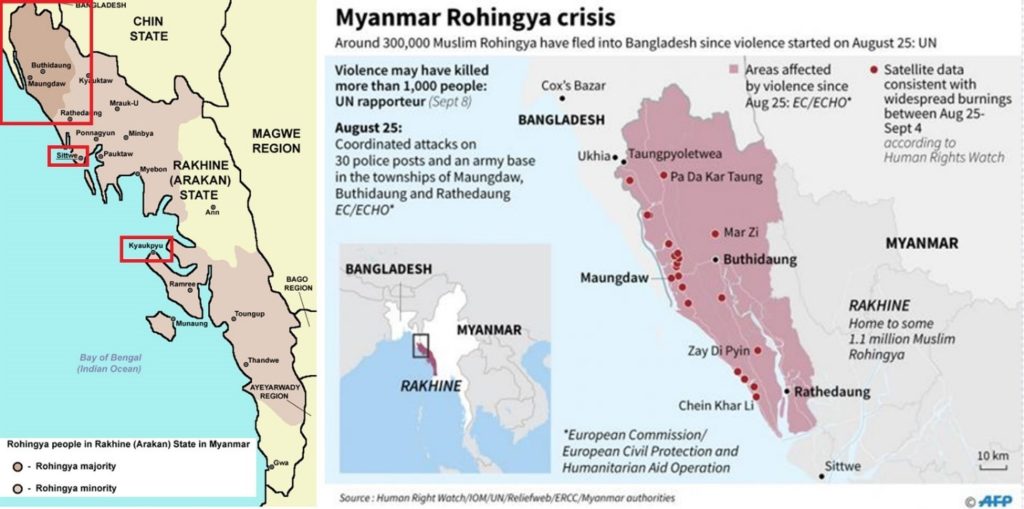
Now consider the location of the developments that are supposedly driving this forced displacement. Kyaukphyu is in central Rakhine state, about 120km south of the present crisis. How can a desire to clear land in Kyaukphyu possibly explain the ethnic cleansing of townships located so far away? Sittwe is also about 40km from the nearest violence.
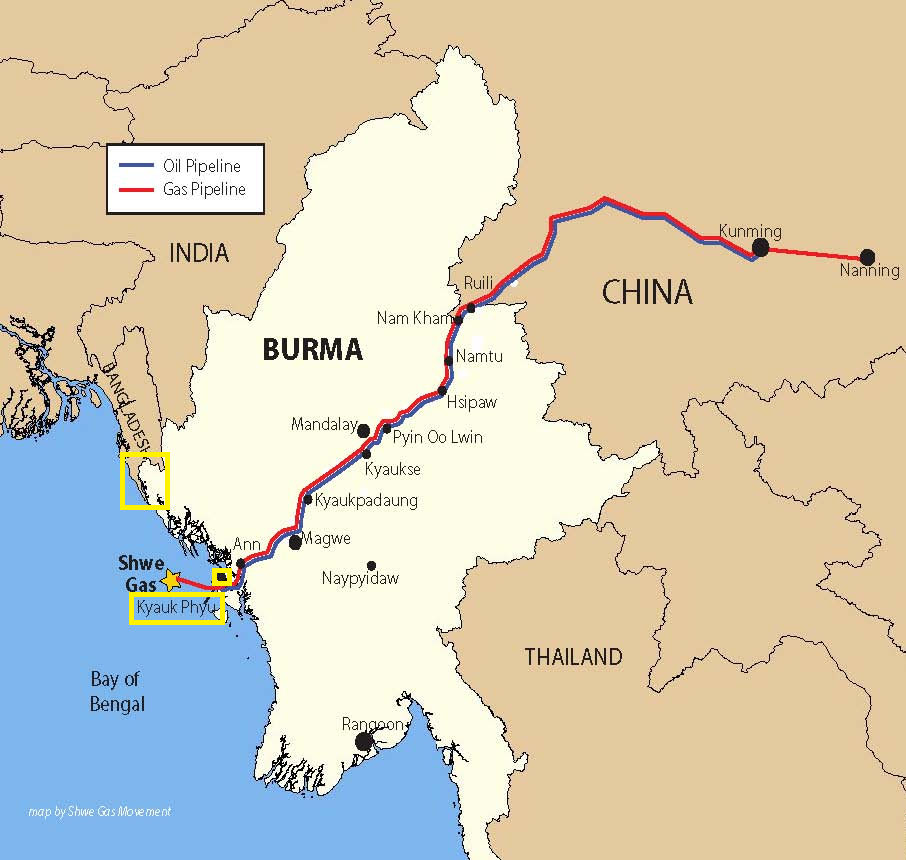
It would be far more plausible to link the present crisis to the shocking announcement, just days into the pogrom, of the state’s intention to establish an SEZ in Maungdaw, at the centre of the recent violence. This certainly deserves investigation, though it is missed entirely in these recent commentaries.
However, this is not just a question of shifting the explanatory weight from one land grab to another. Ultimately, the vulgar Marxism of these accounts does a disservice to political economy analysis more broadly. Attributing complex events like this to “business interests” is crude and reductionist, and can actually explain relatively little. Yes, land grabs have happened across Myanmar to facilitate megaprojects like mines, dams, SEZs, ports and agribusiness plantations, and this has certainly fuelled ethnic conflict. This is well documented by the indefatigable Kevin Woods, whose years of painstaking fieldwork and brilliant scholarship nonetheless goes unacknowledged by these authors. And land grabs, including for the projects cited in these articles, have undoubtedly produced forced displacement in Rakhine state, causing resentment among both Rohingyas and the Buddhist Rakhine, the state’s dominant ethnic group.
But development-induced land grabs simply do not require vast ethnic cleansing displacing 40% of a given population. Nor, crucially, can “business interests” explain why this ethnic cleansing is greeted with indifference or even enthusiasm by the vast majority of Myanmar’s population—even by groups, like the Rakhine, that have themselves been victims of previous land grabs. Nor, crucially, can it explain very similar pogroms in 1977 and 1992, both of which occurred decades before any megaprojects and their associated land grabs.
Towards a better political economy analysis
The only benefit of such crude accounts is that they do prompt us to think about the relationship of sociopolitical conflict to economic factors. This is better than simplistically attributing conflict to “communalism” or “religious intolerance”, as if the problem were solely ideological, lacking any material underpinning—which is never true in reality. But rather than suggesting that the “real” cause is land-grabbing and religion is only a “veil”, it is important to situate sociopolitical conflict within a historically evolving political economy context, in a way that takes social and ideological formations seriously. I can only gesture here at the main lines of analysis one might undertake, but this is still an improvement over the commentary just described.
Buddhist–Muslim conflict over land and resources in what is now Rakhine state is not new. From the fifteenth to eighteenth centuries there were struggles between Muslim empires expanding from the west and the Buddhist Arakan kingdom of Mrauk U, ending only when the area was conquered by the kingdom of Burma in 1785. However, it was British colonialism (1824–1948) that arguably sowed the most important seeds for the contemporary crisis.
Burma was ruled as part of the British Raj, enabling vast inward migration from the Indian subcontinent. The British particularly encouraged Bengalis to migrate to address labour shortages on agricultural plantations. In Akyab district, for instance (present-day Sittwe), from 1871–1911, the Muslim population more than tripled, while the Rakhine population grew by barely a fifth. Understandably, then, the Rakhine have long cultural memories of being “swamped” by “Muslim immigrants”. More broadly, immigration to Burma peaked at 480,000 in 1927, out of a total population of 13 million. By then, ethnic Indians had acquired prominent positions across the Burmese economy, not just as agrarian coolies but also as skilled professionals, merchants and financiers. In the 1930s economic crisis, many farmers indebted to Indian moneylenders defaulted, leading Indians also to become major landlords.
The reaction to this rapid influx was a racially inflected form of economic nationalism which still persists today. This is not entirely dissimilar to the xenophobic nationalism that has sometimes accompanied mass immigration in straitened economic circumstances in many Western countries. There were anti-Indian riots in 1930–31 and specifically anti-Muslim riots in 1926 and 1938. These were led by the majority ethnic Bamar and did not spread into Rakhine itself. It was not until Britain’s defeat by invading Japanese forces in 1942 that communal violence erupted there, with Rakhine militias exploiting the war to wreak bloody vengeance on their Muslim rivals, prompting tens of thousands to flee into India.
To make matters worse, the British then armed Rohingya volunteer forces, ostensibly to attack the occupying Japanese, but instead these groups often raided Rakhine settlements and Buddhist monasteries and pagodas. These forces also accompanied Britain’s reconquest of Rakhine, after which armed Rakhine groups were forcibly suppressed. Understandably, some of the returning Muslims feared being incorporated into the postcolonial Burmese state, launching a “Mujahit” rebellion to press for the incorporation of northern Rakhine into East Pakistan, prompting counterinsurgency operations by the Burmese army through the 1950s.
An important legacy of this WWII-induced displacement, and the subsequent unrest, is that Muslims gradually returning to Rakhine were thereafter often depicted as “illegal Bengali immigrants”. This complex, unhappy history is what lies behind the subsequent rejection of the Rohingyas—a term used commonly only after Burma’s independence—as one of Myanmar’s 135 official “national races”, and their designation instead as “Bengalis”.
Given the experiences under British colonialism, it is not surprising that, from the outset, popular Burmese nationalism has had a strongly racist flavour, directed in part against those branded kalar—dark-skinned “interlopers” from the Indian subcontinent. The central objective of Burma’s post-independence government was the Burmanisation of the foreign-dominated economy. Recalling the trauma of the 1930s, land was nationalised in 1953, and private lending to farmers banned (a situation that largely persists today), eviscerating the remaining Indian landlord class. Burmanisation culminated in the nationalisation of 15,000 businesses after the 1962 military coup, prompting 125,000 to 300,000 ethnic Indians to flee the country. They followed the more than 400,000 Indians, British and Anglo-Burmese who had already left following decolonization. The post-2011 “969” movement, which encouraged Buddhists to boycott Muslim businesses, is arguably just the latest instantiation of this form of xenophobic economic nationalism.
Colonisation also left a legacy of deep religious trauma. On top of the loss of indigenous sovereignty and the influx of Muslims, the British refused to perform the usual duties of Buddhist kingship, such as appointing abbots, and permitted growing Christian missionary activity, provoking a deep sense of cultural crisis among Buddhists. The restoration of Buddhism became central to Bamar nationalism, and steadily this religion, and Bamar culture, became hegemonic elements of postcolonial nation building efforts, with ethnic and religious minorities being increasingly “othered”.
Today, many ordinary Myanmar Buddhists genuinely believe that—like in colonial times—their religion and culture is under threat from a Muslim demographic “tidal wave”. They often point to countries like Indonesia, formerly home to Buddhist and Hindu empires, as examples of what Myanmar will become without vigorous countermeasures. This has virtually no objective basis: only about 3% of Myanmar’s population is Muslim, while around 89% are Buddhist.
But this fact is irrelevant, since most people nevertheless believe it, following decades of government propaganda, atrocious educational provision, and widespread deference to Buddhist monks, some—though far from all—of whom have promoted virulent Islamophobia. Nor is this fear of being culturally overwhelmed new, or somehow a product of the post-2010 “democratic” transition. Anti-Muslim riots occurred under the previous military regime, in 1997 and 2001, and the notorious Buddhist nationalist monk, Ashin Wirathu, the figurehead of MaBaTha, the Association for the Protection of Race and Religion, was jailed for incitement in 2003.
This history explains why there is widespread support today for MaBaTha, for the Protection of Race and Religion Laws (which discriminate against Muslims) and for the ethnic cleansing currently being perpetrated by the Myanmar military. It also explains why, politically, Aung San Suu Kyi has such limited room for manoeuvre—though it must be stressed that she has done virtually nothing to challenge these dangerous myths or to foster intercommunal harmony. Indeed, her own office’s use of the term “Bengali”, her past remarks about “global Muslim power”, and her purging of Muslims from the ranks of NLD parliamentary candidates in 2015, all suggest that she may even personally share anti-Muslim prejudices.
It is the intersection of these material and ideological dynamics that explain the recurrent persecution of the Rohingya and anti-Muslim attacks more generally, rather than a simplistic, short term land-grabbing agenda. Many Muslims were viewed with inherent suspicion due to their association with colonialism and the Mujahit rebellion. After decolonisation, although the term “Rohingya” was used in official circles, they were never formally accepted as one of Burma’s official ethnic groups. Initially, they were allowed to vote, and several were elected to parliament, with one even serving as a junior minister. However, as Bamar Buddhist nationalism intensified, and struggles by ethnic minorities resisting forced homogenisation mounted—prompting the onset of the world’s longest running civil wars—the state became increasingly hostile towards its Muslim population.
In 1962, the army expelled Muslims from its ranks. In 1977, the belief that many “Bengalis” had exploited the state’s weak border controls to cross from East Pakistan/ Bangladesh into Rakhine led the military-backed regime to launch clearance operations ahead of a national census, displacing 200,000 Muslims into Bangladesh. Thereafter, under the new 1982 Citizenship Act, the Rohingyas were gradually stripped of their rights, often finding themselves unable to prove their families’ long-term residency in Burma—thanks in part to the destruction of records in previous rounds of conflict and forced displacement. When, after 1988, the Rohingyas participated prominently in the pro-democracy movement, hoping to recover their rights, they again faced violent suppression, prompting another exodus in 1992, with 250,000 fleeing to Bangladesh.
The position of the Buddhist Rakhine needs special mention here. From their perspective, they have been doubly “victimised”, by a growing “illegal Bengali immigrant” population (even if the Rakhine still outnumber them two to one), and by the Bamar-dominated central government. Rakhine state is Myanmar’s second poorest, and what little development has occurred there has involved either a tiny handful of megaprojects—which create virtually no local employment and whose benefits are monopolised by the regime and foreign investors—or the development of a highly exploitative fisheries industry, with Thai trawlers using quasi-slave labour.
Conditions in Rakhine villages are sometimes scarcely better than those in Rohingya internally-displaced person camps. In conditions of extreme scarcity and economic competition, they profoundly resent the Western focus on the Rohingya, seeing donors as deeply “biased”, which explains violent attacks on aid convoys and protests against donor offices perceived to have slighted Buddhism. The Rakhines have seized the opportunity offered by the post-2010 transition to organise politically, dominating the state assembly. Many have also supported heavy handed military and police action as a long awaited form of redress against their local rivals, and have exploited periods of unrest to seize land used by Rohingyas. However, some have even joined the Rohingyas in exile, reflecting a shared sense of desperation and impoverishment.
It is hardly surprising that these extraordinarily grim conditions have spawned violence among both communities. Rakhine militias organised to attack Muslims during the 1940s, and today three are active, all of which promote “self-determination” in Rakhine but reject the Rohingyas as “Bengalis”. The Rohingyas have also taken up arms periodically, and the only mystery is why the latest armed group, the Arakan Rohingya Salvation Army (ARSA), has taken quite so long to form in the face of such harsh persecution and misery. ARSA’s attacks on police and army outposts—the most recent of which, in late August, triggered the army offensive behind the present refugee crisis—smack heavily of desperation, as men often armed only with catapults and wooden “guns” launch themselves at the security forces.
In short, while simple pecuniary motives can never be entirely discounted, particularly in Myanmar’s borderlands, the political economy underpinning the current Rohingya crisis is far more complicated than is suggested in articles making a few sloppy references to megaprojects and land grabs. Ultimately, like Myanmar’s other ethnic conflicts, it reflects the crisis-ridden nature of the Burmese state since its inception.
Burma was founded with no real meaningful consensus among its population groups over the nature of the state or nation, or the extent of power and resource sharing. Bamar-Buddhist chauvinists, unprepared to make the concessions needed to secure others’ consensual participation in nation-building, have instead sought to impose their vision by force, leading to brutality across the borderlands. However, the Rohingya have suffered particularly harshly because their claim to ethnic-minority status is not even recognised. While the Bamar state seeks to coercively incorporate recognised ethnic minority groups into the Union, it seeks to coercively exclude the unrecognised Rohingya. That is, ultimately, traceable to British colonialism and its legacy.
…………………………
Lee Jones is Reader in International Politics at Queen Mary University of London’s School of Politics and International Relations. He has written extensively on Myanmar’s political economy, regime transition, experience under sanctions, and relations with China. You can follow him on Twitter at @DrLeeJones.
Header image of the Jama Masjid in Sittwe via Flickr user Adam Jones, used under Creative Commons.
 Facebook
Facebook  Twitter
Twitter  Soundcloud
Soundcloud  Youtube
Youtube  Rss
Rss 